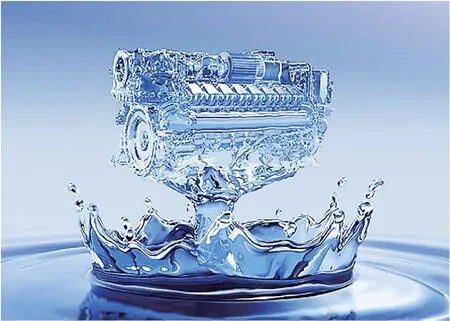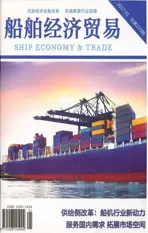供给侧改革:船机行业新动力
2017-02-23王孙
本刊记者 王孙
供给侧改革:船机行业新动力
本刊记者 王孙

金东寒
当前,中国船用发动机行业仍存在产业集中度不高、二轮配套供应链不完善,总装及配套企业自主创新能力不足等问题。
作为船舶的“心脏”,船用发动机的发展现状与船舶制造业以及航运业的发展息息相关。日前,在2016年上海航运交易论坛上,中国工程院院士、中国内燃机学会副理事长、上海大学校长金东寒对船用发动机行业的现状及发展前景进行了分析、展望。他认为,未来船用柴油机的技术发展趋势将呈现五大特点:高效率、低排放、高可靠性、采用电喷技术以及便于操作和维护。
船机行业面临众多挑战
当前,船用柴油机的技术发展正面临着重重挑战。金东寒指出,航运业现已成为有害气体排放的重要源头,其二氧化碳、氮氧化物、二氧化硫等有害气体的排放量,已大大超过航空业,接近于道路交通业,被视为第二大污染源。由此,国际海事组织对有害物质排放的要求日趋严格,自2011年开始执行氮氧化物Tier II的排放标准。与此同时,船东对发动机的要求也越来越高,且与船厂要求的侧重点有所不同。作为船东,通常更注重发动机的可靠性,希望购买有过使用经历的厂家的产品,技术要比较成熟,不能出现不可预见的停机或故障;而船厂则更关注采购价格,不太关注油耗和维护成本,只要船东同意,采购价格越低越好。
在油价方面,从本世纪初开始,国际油价持续上涨,7年翻了两番;但自2011年以后,油价逐渐下降,2016年开始止跌回升。金东寒认为,从长远来看,油价不可能总是保持低位,市场毕竟有刚性需求,因为燃油是机动动力的主要能源,如中国进口石油的60%都是由内燃机所消耗掉。此外,原油开发的成本也在不断增高,低油价应该只是暂时的。
“节约能源”和“减少排放”是当今全球航运界两大热点话题,尤其是减排已成为推动船用发动机技术发展的第一驱动力。金东寒认为,船用柴油机将继续呈现出结构紧凑模块化、操作简单智能化、高效节能低排放、安全可靠高寿命等发展趋势。据他介绍,近年来,氮氧化物(NOx)的减排技术、高增压技术、低NOx燃料技术、燃气再循环技术等已经逐渐得到应用,如曼柴油机与透平公司推出的模块化选择性催化还原(SCR)系统已应用于船舶上,截至2014年已使用7000多小时。此外,双燃料低速机也是一个重要的发展方向。过去十年来,对于液化天然气(LNG)燃料在船用发动机上的应用已有广泛研究,并在多种船型上进行了实验和示范。瓦锡兰的双燃料发动机已在60多艘船舶上使用,累计运行150万小时。还有一种技术,即能源综合利用技术,在船舶发动机各种负荷下,其回收的能量可使能效提高10%—15%。它主要是将主机废热收集起来再用于发电,或者用POI、POT等技术。
中国企业仍有差距
目前,中国已初步形成船用柴油机及其配套件的生产体系。据金东寒介绍,2013年以前,中国船用柴油机的产能以每年20%的速度迅猛增长,目前产量位居全球第二。2012年,全球中低速船用柴油机的产量约为5000万马力,中国、日本、韩国、欧洲分别占29%、18%、48%和5%。在国际上,船用低速机的产业集中度非常高,排名前十位企业的产量占比超过90%,中日韩各占3家,中国企业的排名普遍靠后。

沪东重机研制的12MV390中速柴油机
对于中国船用柴油机制造企业面临的问题,金东寒分析指出:首先,整机企业规模小而数量多,生产效率与日韩相比还有一定差距,产业集中度不高,规模效应不明显。其次,二轮配套供应链不完善,配套厂专业化程度不高,规模偏小,同质化竞争现象较突出,管理水平不高,质量不稳定,零部件国产化率相对较低,尤其是一些高端零部件还未能实现本土化。再次,大多数船用柴油机制造及其配套企业缺乏研发能力,无法通过自主创新掌握关键技术和新技术,甚至在工艺技术方面的创新成果也不多,造成只能通过拼价格来竞争,更没有能力通过提供优化的动力系统解决方案为用户提供增值服务来获得竞争优势。

多举措提高本土产品装船率
金东寒表示,最近几年,我国船用发动机行业的供给侧改革取得了一些成效。对于未来的发展,他建议,政府应制定鼓励政策,加快推进船用发动机高端零部件国产化,提高本土化水平和装船率;鼓励发动机行业内进行必要的整合,尤其是鼓励按照混合所有制的改革方向进行兼并重组,提高企业的活力和产业集中度;允许相关企业加强对一些关键零部件进行二次开发,实现引进技术消化吸收再创新。对于船用发动机制造企业而言,要密切关注用户的需求,继续加大科研投入,积极开发自主品牌产品,加强全球服务网的建设;重视节能减排技术的自主开发,努力占据产业制高点;整机企业还应积极参与高性能、低能效的绿色船舶的设计,打破国外的法规壁垒。
金东寒曾任中船重工七一一研究所所长,长期致力于船用发动机研制工作。如今,他虽已离开船舶行业,但还任上海市船舶与海洋工程学会副理事长,对于船用发动机的发展仍是不忘初心。他认为,我国自主研发的船舶配套产品在推广使用方面还存在很大的阻力,中国目前生产的船用发动机技术先进,产品质量也能够保证,但还是有很多船东、船企选择去日本、韩国订购主机,不想当“第一个吃螃蟹的人”,这不仅会使船配企业面临很大的经营困难,也将严重打击他们创新的积极性。在当前的市场形势下,国有航运企业、船企也要承担相应的责任,优先考虑使用国内的配套产品。如果大家都有责任感,就能通过抱团取暖,抵御危机,实现共同发展。★
As the ship heart, development status of marine engines is closely bound up with development of the shipbuilding and shipping industries. Jin Donghan, academician of the Chinese Academy of Engineering, vice chairman of the Chinese Society for Internal Combustion Engine (CSICE) and president of Shanghai University, analyzed and looked forward into the status and perspective of the marine engines sector. In his opinion, future technical trends of marine engines will present five features: High efficiency, low emission, high reliability, applying electrical injection technology and facilitating operation and maintenance.
At present, China preliminarily built a marine engine and parts and components production system. According to Jin Donghan, before 2013, China marine engine capacity saw an annual 20% boom and current production ranks second on the globe. In 2012 global middle-low-speed marine engine production stood at about 50 million Horsepower, with China, Japan, Korea and Europe accounting for 29%, 18%, 48% and 5% respectively. International low-speed marine engine industry concentration is very high, Top 10 production exceeds 90%, China, Japan and Korea each amounts to three, and Chinese manufacturers are generally in the rear ranking.
About problems faced by Chinese marine engine manufacturers, Jin Donghan said first, complete machine manufacturers feature large number and small scale, productivity leaves some gap with Japanese and Korean counterparts, with moderate industrial concentration and scale effect. Second, second-round supply chain is incomplete, marine equipment manufacturers have moderate degree of specialization, scale is on the small side, with obvious homogeneous competition, low management level, unstable quality, relatively low localization of parts and components, especially non localization of some highend parts and components. Thirdly, most marine equipment manufacturers and supporters lack R&D capability, unable to grasp key technology and new technology through independent innovation, only a few innovation achievements in process technology. This results in price war, unable to provide value-added services for users to obtain competitiveness advantages by providing optimal power system solutions.
Jin Donghan said over recent years supply-side reform of the Chinese marine engine industry has achieved some results. Regarding future development, he suggested the government should formulate incentive policy to accelerate marine engine high-end parts localization and raise localization and on-board mounting rate; encourage necessary engine integration, particularly encourage M&G and regrouping in mixed ownership reform direction, and improve corporate viability and industrial concentration; allow secondary development of key parts by relevant manufacturers and realize technology introduction, digestion, absorption and re-innovation. Marine engine manufacturers should closely watch out user's need, go on with research input and active development of independent brand product and strengthen global service network construction; attach importance to independent development of energysaving and emission-reduction technology in a bid to take industrial commanding height. Complete machine manufacturers should also actively take part in design of highperformance and low energy efficiency green ships and break through overall legal barrier.
Supply-side reform: New power for marine engines
By Wang Sun
